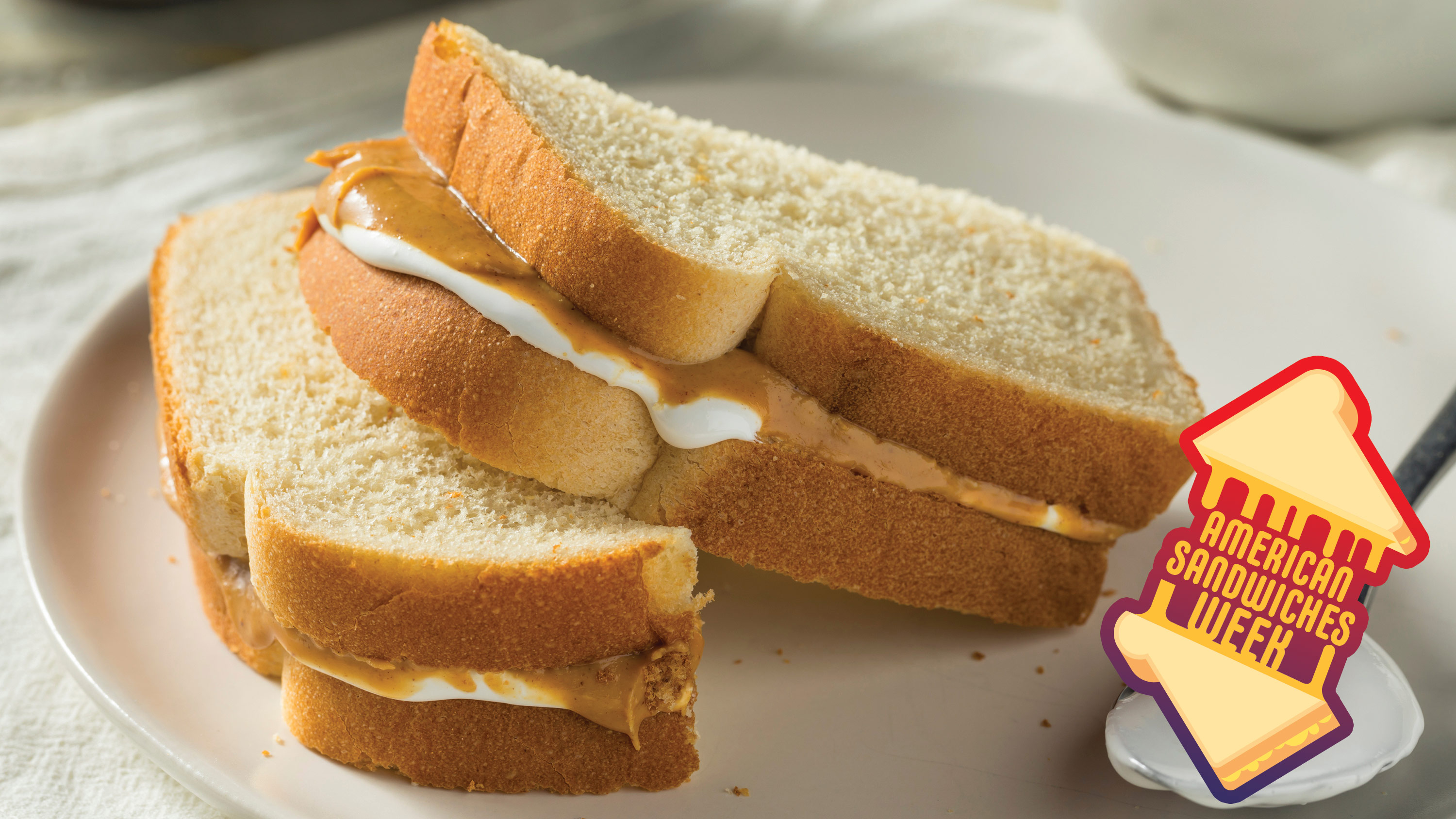The Fluffernutter Is A Sticky, Contested New England Delicacy
Welcome to American Sandwiches Week, a celebration of the mighty sandwich through the lens of Americana.
My favorite thing about New Englanders is our willingness to double down on even the most arbitrary of arguments. Small in size and scrappy by nature, we will fight to the death to defend our regional favorites (see: Tom Brady, Dunkin' [Donuts], authentic maple syrup). New Englanders would rather die than back down from a fight. In 2006, Massachusetts state government decided to test this misplaced conviction by applying it to a dubiously pressing problem: the question of what to do with the Fluffernutter sandwich.
In one corner stood Jarrett T. Barrios, a Massachusetts state senator and upset parent. His son had been served a Fluffernutter sandwich at school and Senator Barrios was concerned about the meal's nutritional value. He argued that the Fluffernutter—a sandwich made by combining peanut butter and marshmallow cream on white bread—was not an acceptable option for children born in a country with an obesity problem. "I'm not sure we should be even calling it a food," he said, before threatening to file an amendment forbidding schools from serving fluff more than once a week. It was a bold move, no less because New England's preferred fluff brand, Marshmallow Fluff, was invented in Sen. Barrios' home district of Somerville.
For the Massachusetts born and bred, the prospect of regulating fluff was perceived as a personal attack. In an impressive display of political pettiness, State Rep. Kathi-Anne Reinstein responded by proposing a bill that would make the Fluffernutter Massachusetts' official state sandwich. The two sides then proceeded to argue the point in the Massachusetts State Legislature for an entire week.
Bite-sized Fluffernutters were distributed in an effort to garner support for the bid. Weight Watchers points and fat content were analyzed ad nauseam. Locals engaged in contentious debates on internet message boards and the national media broke out their best fluff puns. 2006 was a simpler time.
Sen. Barrios ultimately dropped his amendment, pointing out that the fuss over the legislation was undercutting his nutritional concerns. Rep. Reinstein's proposal floundered in the State House for nine years and today, the Fluffernutter is considered Massachusetts' state sandwich—but only unofficially.
It's clear from the mildly condescending articles written by the national news during this period that the rest of the world could not wrap their heads around a fight over fluff. But for those of us who grew up eating the beloved sandwich, the attacks on the Fluffernutter created a culinary flash point. An assault on the Fluffernutter wasn't just an issue of New England food identity politics—it was an assault on Massachusetts history.
The Fluffernutter has many claims of origin, but most give credit to siblings Emma and Amory Curtis. In the early 1900s, Amory created a spread called Snowflake Marshmallow Crème in the basement of his Melrose, Massachusetts home. This spread became the first marshmallow cream available for public purchase, and the timing couldn't have been better. During World War I, Americans were encouraged to abstain from eating meat one day a week to show support for the troops. In 1918, Emma published a recipe for the "Liberty Sandwich"—a vegetarian sandwich option consisting of layered peanut butter and marshmallow crème. The rest is history.
The beauty of the Fluffernutter lies in its inherent simplicity. Assembly requires only two pieces of white bread (people who use wheat are lying to themselves), peanut butter—brand irrelevant—and Marshmallow Fluff. Marshmallow Fluff is known for its instantly recognizable red, white, and blue jars, which are specially designed to provide maximum grip, a functional necessity as fluff has an unfortunate habit of gluing the jar's lid to its lip.
More dessert than entrée, more exotic than peanut butter and jelly, the Fluffernutter is simple enough for a child to make independently, yet can easily be gussied up with the addition of toasted bread, bananas, powdered sugar, or Nutella. As long as you don't look too closely at the sandwich's sugar content, the Fluffernutter is a meal that both children and their overworked parents can get behind.
The process of creating a Fluffernutter is as intuitive as it gets, but that didn't stop Durkee-Mower, Marshmallow Fluff's parent company, from hiring a PR firm to compose a jingle instructing aspiring Fluffernutter eaters how to first construct, then enjoy, the sandwich.
The Fluffernutter Song
Oh you need fluff, fluff, fluffTo make a fluffernutterMarshmallow fluffAnd lots of peanut butter
First you spread, spread, spreadYour bread with peanut butterAnd marshmallow fluffAnd have a Fluffernutter
When you enjoy, enjoy, enjoyYour fluff and peanut butterYou're glad you have enoughFor another Fluffernutter
It's been 100 years since Emma Curtis first published her recipe for the Liberty Sandwich. And political attacks notwithstanding, it seems unlikely the Fluffernutter is going away any time soon. It may have failed to assume its place as Massachusetts's official state sandwich, but the Fluffernutter remains a sweet and endlessly sticky reminder of a New England childhood.
